Dr Vino's wine blog
wine talk that goes down easy
Bottle deposit reform could add $200 million to NY’s coffers
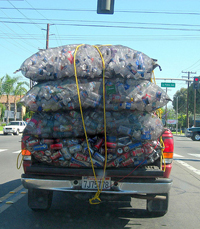 Governor Paterson and legislators in Albany are trying to reach compromises to close the yawning gap in New York’s budget. Although the proposal to sell wine in grocery stores is back on the table, there is another drinks-related area our officials have yet to uncork: bottle deposits.
Governor Paterson and legislators in Albany are trying to reach compromises to close the yawning gap in New York’s budget. Although the proposal to sell wine in grocery stores is back on the table, there is another drinks-related area our officials have yet to uncork: bottle deposits.
Last year, a reform bottle bill passed–largely unnoticed–that included significant changes, notably extending the deposit to include water containers and sport drinks. Further, and more importantly, the system for unredeemed deposits was redirected to send 80% of those funds to the state’s Department of Finance; previously, unredeemed funds rested with the deposit initiators (often beer and soda distributors). This long-overdue reform will bring in an estimated $90 million this year to the state.
But at five cents per container, the deposit remains low, unchanged since the program started in 1982. During the first decade of the bottle bill, redemption rates hovered around 80%. As inflation has eroded the value of the deposit amount, the redemption rate has fallen (details in this pdf).
Raising the deposit rate to ten cents (about even with inflation) even twenty cents per container would have the effect of raising recycling rates and raising revenues for the state through unclaimed redemptions. In 2006 (before water and sport drink bottles were included), deposits collected totaled $289 million while $196 million were redeemed, a 67.8% rate. Doubling the per bottle deposit to 10 cents, would mean $600 million in deposits, while raising the rate to 20 cents would gross $1.2 billion. Even assuming that were to bring the redemption rate back to 80 percent, that would still result in an additional $96 million or $192 million in uncollected deposits for the states coffers. (Raising the state’s share of unredeemed deposits to 90% or higher, would boost state revenues even further.)
That’s a kind of win-win we don’t see too often in Albany. And one that legislators and the governor could proudly raise a glass to.
Related: “Should a bigger better bottle bill include wine bottle deposits?”
Tony Soter sheds some weight [carbon footprint]
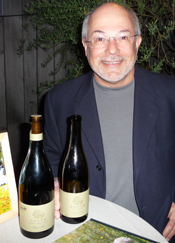 Tony Soter shed some unnecessary weight from one year to the next–in his bottles.
Tony Soter shed some unnecessary weight from one year to the next–in his bottles.
The Oregon vintner shipped his 2007 Pinot Noirs in bottles weighing 900g, more than the 750g of wine in the bottle. But for his 2008s, which are being released soon, the bottles will weigh 600g (both bottles, pictured right). Needless to say, the reduced packaging mass greatly reduces the carbon footprint of the wine.
“The time has passed that you can try to impress people with the substance of the bottle as opposed to what is in the bottle,” he said.
He also thought it odd to import tons of empty glass bottles from France, so started sourcing his bottles locally. One new facility near Portland is getting underway making recycled glass from hydro-electric power. Currently, he is sourcing the glass from Seattle. Other vintners in the area are also taking steps to make their bottles more lightweight, he said.
Here at the Dr. Vino World Headquarters, we raise an ultralight crystal stem of Willamette Valley Pinot Noir in their honor!
Why is there so little Biodynamic wine in Bordeaux?
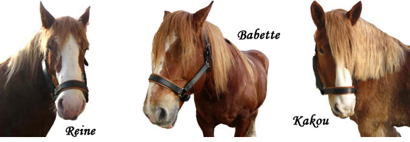
One of the 2009 wines that generated favorable comments at last week’s en primeur tastings in Bordeaux was Pontet-Canet in Pauillac. Over on Twitter, there was some confusion about the status of their Biodynamic certification. So I asked Alfred Tesseron who sent in a clarifying response that follows after the jump.
Given that Pontet-Canet is one of the rare properties in the Médoc (and Bordeaux, generally), I also asked the Twitterverse for their theories on why there isn’t more grape growing in the region done according to Biodynamics (a sort of homeopathic method guided by the celestial). Here are their <140 character replies, in chronological order of response:
@mrmansell: maybe bordeaux doesn’t need the gimmick to move wine?
@TimAtkin: It costs money. And would reduce profitability. Also it’s seen as Burgundian.
@JancisRobinson: In BDX commerce rules – v anti beard/sandal ethos. Plus, Atlantic rains bring extra problems. Ask A Tesseron at Pontet Canet.
@JossNOTJosh: Size of properties. 0.5 ha of Pommard much easier than 50 ha of Pauillac.
@waterintowino: maybe bordeaux wines arent as transparent and nuanced to show diff in biodynamics
@newbordeaux: I agree with Jancis and Joss – size of estates and climate here make it very difficult. But there are increasing numbers trying.
@kcoleuncorked: Because it’s not an area known for on-site, hands-on vignerons & small estates.
And the note from Alfred Tesseron of Pontet-Canet: Read more…
Is there an eco-certification premium but an eco-label discount?
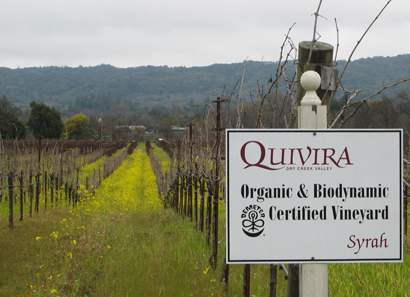
Why don’t green-minded vintners and vignerons always display their eco-friendly methods on the label?
I’ve often asked why and replies generally come in the form of the producer’s desire to have the wine liked for the quality as opposed to the methodology per se. Or, where organic in spirit, a common reply has been a dislike for administrative costs of filing and/or wanting to maintain the flexibility to spray if necessary.
An academic paper presents findings that may not lead to more eco-labeling: Certifying a winery as organic or Biodynamic will raise the price of wine 13 percent but putting that on the label will see the price fall by 20 percent.
Magali Delmas and Laura Grant, of UCLA and UCSB respectively, examined 13,400 California wines from an eight-year period ending in 2005 to reach their conclusions, which will appear in a forthcoming issue of the journal Business & Society. It’s certainly possible to quibble with their data: only 28 of the all-California wineries were certified and only 16 of the wines in the data set received the eco-labeling. The wines were expensive (about $37 a bottle) and the quality bump, as measured by WS scores, was slight (less than one point) as well as low, scoring less than 84.
They explain the premium for certification largely as the good will recognition akin to club membership. It would be interesting if they could explore quality further as I think that could be more convincing than the social effect in explaining the premium.
To explain the discount for labeling, they cite various winemakers who say that “organic” remains a stigma in the eyes of consumers. Such a comment seems oddly disconnected with the current era of Whole Foods and local and sustainable foods; younger consumers don’t see it as a stigma, I’d venture to say.
Part of the reason for the discount, they argue, is consumer confusion over the various labels and certifications, particularly since so few wines qualify for the organic standard, thus only qualifying for the looser “made from organically grown grapes” standard. They also show that consumers have little knowledge of Biodynamics with only 17 percent of respondents in a previous study being familiar with the term and only eight percent having tried a Biodynamic wine. (Of the respondents who were unfamiliar with the term, the single largest response as to what it meant was that it was genetically engineered or modified.)
What do you think–why is there an apparent discount for eco-labeling as opposed to eco-certification?
Delmas, M. and Grant, L. Forthcoming. “Eco-labeling Strategies and Price-Premium: The Wine Industry Puzzle.” Business and Society. (pdf)
Astor Wines says no to Styro, yes to plastic sleeves
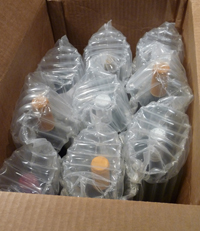 I got a few wines from Astor Wine & Spirits in Greenwich Village via UPS the other day. When I opened the box, there was no Styrofoam. There weren’t any cardboard inserts. Instead, each bottle was wrapped in an inflatable plastic sleeve. It was the first time I’d seen this.
I got a few wines from Astor Wine & Spirits in Greenwich Village via UPS the other day. When I opened the box, there was no Styrofoam. There weren’t any cardboard inserts. Instead, each bottle was wrapped in an inflatable plastic sleeve. It was the first time I’d seen this.
Styrofoam is popular with retailers and wineries shipping wine because it cradles and insulates the bottles. While it is ultralight, thereby reducing the carbon footprint of the shipment, it essentially never biodegrades. I always try to bring my Styro shippers back to a store so that they can be used again before their life taking up space in a landfill. One store, Grapes the Wine Company, actually includes a pre-paid label so consumers can return the empty box back to the store via Fedex for reuse and a store credit. Corrugated cardboard inserts are recyclable but they are quite heavy, increasing the carbon footprint. Pulp inserts are light and biodegradable.
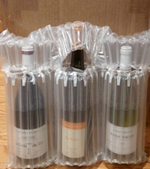 The plastic sleeves that Astor uses, branded as Air-Paq, are both light and recyclable (though they are resin code 7, which many municipalities don’t recycle). Their staff inserts the bottles in the sleeve, then use a gizmo to inject the air and seal the sleeve (you can see a scintillating demo video here).
The plastic sleeves that Astor uses, branded as Air-Paq, are both light and recyclable (though they are resin code 7, which many municipalities don’t recycle). Their staff inserts the bottles in the sleeve, then use a gizmo to inject the air and seal the sleeve (you can see a scintillating demo video here).
Reached via email, Andrew Fisher, owner of Astor, pointed out that it is much more space-efficient in their shipping area than Styrofoam, since there is just a plastic roll and a compressor. He elaborated, “Since Astor produces its own electricity and recaptures the waste heat to provide heating and cooling for our space, it seemed both incongruous and inconsistent to cling to Styrofoam shipping materials.”
Each bottle rests in an independent sleeve from the others so it can also be separated and used again for your wine travel needs. Or, if you have two boys like us, they each can put them on a hand and have a sword fight!
Related: “Poll: Styrofoam or cardboard for your wine shipping?“
Jason Haas can’t find lightweight bottles that don’t look cheap
 Jason Haas went to Sacramento thinking thin. He came away disappointed.
Jason Haas went to Sacramento thinking thin. He came away disappointed.
Although it’s known for belt-tightening of a different kind, Sacramento is not known as a weight-loss destination. In fact, Haas, the general manager at Tablas Creek Vineyards in Paso Robles was attending an enormous wine trade show. He recounts on his blog how set out to find a lighter bottle for his top wine, Esprit de Beaucastel, a red blend that retails for about $50. But, in the end, he wasn’t happy:
It became clear that the bottle manufacturers have been taken by surprise with wineries’ desires for lighter bottles. Most of the lightest bottles that they make still are intended for the lowest-end wines. They look cheap. What we’re looking for is a bottle that looks like a top-end bottle, but weighs half as much. And, somewhat to our surprise, those bottles just don’t exist yet.
Talking PET, Paks, & pouches with Dave Pearce of Grove Mill
 Dave Pearce crunches carbon numbers for breakfast. The kiwi winemaker at Grove Mill winery has studied the carbon footprint of wine, reduced what emissions he can at his winery, and purchased offsets for the rest.
Dave Pearce crunches carbon numbers for breakfast. The kiwi winemaker at Grove Mill winery has studied the carbon footprint of wine, reduced what emissions he can at his winery, and purchased offsets for the rest.
We sat down over a macchiato in NYC one morning and discussed his views on alternative packaging. Although he recognizes the weight of glass and its role in the overall carbon footprint, his own wines still come in glass bottles. His thoughts, in brief: Read more…
Explosion, On the Rocks, lightest bottle, millennials – sipped and spit
BLOWN: box wine
After news of an implosion yesterday, today we bring you an explosion for all your demolition needs. (Via @upgradetravel)
SIPPED: Jancis, rocked
A German sommelier who goes by the nom de internet of Finkus Bripp drops by Jancis Robinson’s house to interview her. No exploding microwaves, sadly, but worth a look nonetheless. [Wine on the Rocks]
SIPPED: slim bottles
The wine bottle makes good on its resolution to lose weight: Tesco introduces an ultralight glass bottle that weighs just 300g, or, significantly less than normal bottles. That means more wine shipped around the world, and less packaging. Take a look at the bottle over on wineanorak.com.
SIPPED: more freedom of shipping
A federal appeals court affirmed a lower court’s ruling that Massachusetts law could not offer free shipping to in-state wineries over 30,000 gallons a year while preventing out-of-state wineries from shipping. Wineries producing more than the 12,618 case limit rejoiced at the ruling–as did free trading consumers. [AP]
SIPPED: the “new normal”
What’s in store for the wine biz? “Slow growth, lower prices and younger fans who are drinking more at home than at fancy restaurants.” [Wines & Vines]
SIPPED and SPIT: new wineries
The number of new wineries in the USA increased by six percent, according to Wine Business Monthly. Although this is up, the growth slowed to from 15 and 10 percent in 2006 and 2007, respectively. It was the same growth rate as last year. Related question: does the US need six percent more wineries?
SIPPED: Discussion
Randy and Kaz, the hosts of WineBizRadio invited me on last week to talk about my post about wine samples at the Wine Advocate.



